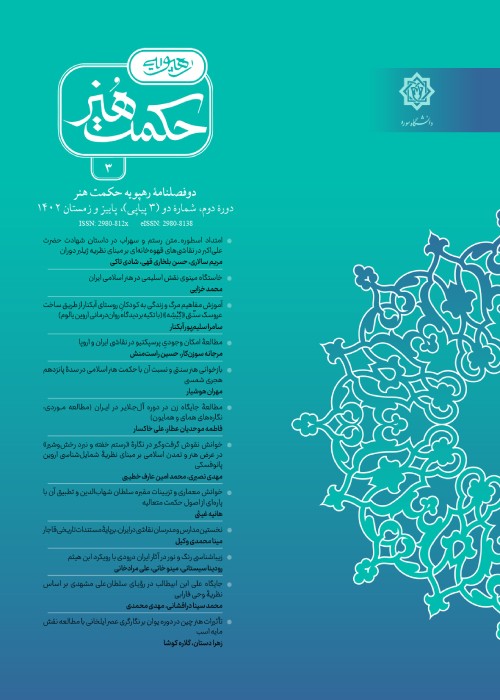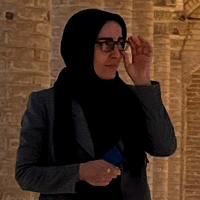The Reflection of Seluk Stages in Two Wall Paintings "Old Dervish" and "Young Seeker" from the Pictures of Hafttanan Mansion of Zendieh Era
Author(s):
Article Type:
Research/Original Article (بدون رتبه معتبر)
Abstract:
Visual documents are significant as first-hand illustrated sources in any period and express thought patterns and thought in different periods. From this point of view, the remaining wall paintings from the Zendiyeh era in the Hafttanan building of Shiraz are important and show special information about the common literary and mystical themes and foundations of the mentioned period. This research tries to read two pictures, one of the artworks in Hafttanan's Building, from the perspective of mystical cryptology. It seems that the two pictures of the mentioned mansion refer to the houses of the seven stages. Dervish tools, accessories and clothes in the pictures help guide the research. This article explores the mystical themes of young and old two picture Dervishes, which are also attributed to Saadi and Hafez or Saadi and Shah Abbas in some texts, in the context of reflection theory. The aim of this research will be an approach to the image system of two images of old and young dervish in relation to the authorities of mystical behavior. It seems that signs and symbols in the form of Sufis' customs and instruments can be seen in the paintings, which are related to their position in the path of their conduct. How are the bag, hand stick or mantasha, kashkul and tabarzin, many Turkish hats and special robes effective in explaining their position in the way of conduct? The explanation of the position of Kashkul and Tabarzin, Mantasha and Pashak have a significant relationship with their position in the path of the Seluk. Dongareh, one of the wall paintings of the Hafttanan monument in Shiraz, from the works of the Zendiyeh period, are the study examples of the present research. The research is descriptive and analytical from the point of view of its nature and method, and considering the purpose of the research, it belongs to the category of theoretical research. The collected information is the result of library studies and recording field observations, and the theoretical framework is inspired by Victoria Alexander's reflection theory. The result of the article reflects the stages of seeking, knowledge, poverty and annihilation in the researched paintings. Mentsha, Chante, Kashkul and Tabarzin are important signs in conveying meaning. In other words, the mentioned objects and tools indicate the belonging of the seekers to the way of walking. Many similarities between signs and symbols can be seen in each two pictures, with the difference that Mantsha, horn and ring are not seen in the image of the elderly dervish, and they are not present in the image of the young dervish of Tabarzin. The presence of old and young dervishes, as well as their specific building and mansion (the Hafttanan mansion), as well as the travelogues, narratives and stories in popular culture, are proof of the improvement of the status of this class in the twelfth century of Lunar Hijri. In this article, their clothes, tools and equipment were studied. Some signs point to the position of two dervishes, old and young, on the path of pilgrimage. They are symbols of their poverty, contentment and remembrance. Even in the image of a young dervish, the use of a ring in the ear refers to belonging to a Heydari dervish. Many Turkish hats, sticks or canes, kashkul and ax, wind instrument and ring (earring) are the most important symbols known in every picture, which express deep concepts of the situation of dervishes in the Zandiya era. Artworks are superstructures that provide detailed information about the society's infrastructure to the audience and researchers.
Keywords:
Language:
Persian
Published:
Journal of Rahppoye, Hekmat-e Honar, Volume:2 Issue: 1, 2023
Pages:
109 to 118
magiran.com/p2590958
دانلود و مطالعه متن این مقاله با یکی از روشهای زیر امکان پذیر است:
اشتراک شخصی
با عضویت و پرداخت آنلاین حق اشتراک یکساله به مبلغ 1,390,000ريال میتوانید 70 عنوان مطلب دانلود کنید!
اشتراک سازمانی
به کتابخانه دانشگاه یا محل کار خود پیشنهاد کنید تا اشتراک سازمانی این پایگاه را برای دسترسی نامحدود همه کاربران به متن مطالب تهیه نمایند!
توجه!
- حق عضویت دریافتی صرف حمایت از نشریات عضو و نگهداری، تکمیل و توسعه مگیران میشود.
- پرداخت حق اشتراک و دانلود مقالات اجازه بازنشر آن در سایر رسانههای چاپی و دیجیتال را به کاربر نمیدهد.
In order to view content subscription is required
Personal subscription
Subscribe magiran.com for 70 € euros via PayPal and download 70 articles during a year.
Organization subscription
Please contact us to subscribe your university or library for unlimited access!



